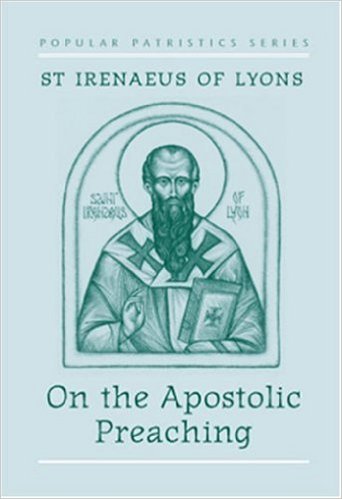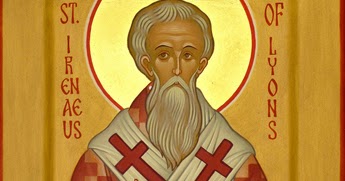O’Donovan, Oliver and O’Donovan, Joan Lockwood. From Irenaeus to Grotius. Grand Rapids, MI: Eerdmans.
This sourcebook is divided into five parts: The Patristic Age, Late Antiquity and Germanic Kingship, The Integration of Aristotle, Spiritual Polities and Dominum, and Renaissance and reformation. At the risk of sounding Hegelian (purely accidental) we see the O’Donovans guiding us through the struggles each age had to face in integrating biblical truth, not only with their present culture, but with the achievements of previous ages.
The Patristic Age
Christian thinkers had to wrestle with the uncomfortable fact that the NT praised Roman soldiers with the present reality of Rome’s attack on the faith. Further, military service, whatever conclusion one reached, challenged ideas of continuity.
Eschatology factored heavier in these accounts. As a separate community living in the time between the times, they awaited the arrival of Yahweh and the judgment of the age. This sheds light on the confrontational (spiritual, anyway) atmosphere: thinkers like Irenaeus and Cyril of Jerusalem saw a coming showdown with Antichrist (quoted in O’Donovan 41).
Several themes emerge in the Patristic Age, mainly the note of Evangelical Poverty. Property, as defined by Lactantius, is defined “precisely by the structures of community relations in which material goods are communicated” (O’Donovan 47). This means human existence has a fundamental sociality. For the most part, the fathers–and the tradition as a whole-avoid calling private property evil. But it is always deconstructed. They see property as already existing within community. It is to enable the trustee to better rule and share.
The Transition: Towards the end of the age both East and West will have been shaped by Justinian’s Law. The West would move to see links between Christology and political imagination (cf Kantorowicz)
Late Antiquity and Romano-Germanic Kingship
Germanic warrior-kings provided an alternative to the orientalizing-divinization cult. The ecclesiastical structure begins to see itself as more separate (and often superior) to the political order. Moreover, the episcopate is looked to as a model for rule. Not surprisingly, and perhaps contrary to earlier gains, there is a return to the idea of a theocratic priest-king (again see Kantorowicz).
Consistent with the warrior-king motif, and O’Donovan really does not dwell overly much on it, is the idea of David as a type of later Christian kings.
Transition: Not exactly a transition moment, but of immense importance was Pope Gelasius’s idea of the “two swords,” dual rulership (179, “There are two by whom the world is ruled, priest and king”). Ambiguities in this model will create tensions when Aristotle comes on the scene.
The Struggle over Empire and the Integration of Aristotle.
Pope Gelasius’s formulation, for all of its difficulties, never united the two swords into one person. The temptation, however, would later prove too great. The Papacy would develop the idea of plenitude potestasis, combining theology, law, and metaphysics into one. One result would be the increasing corporatization of the church, indeed a “corporation of corporations” (O’Donovan 235; again see Kantorowicz).
The corporatization of the church brought an old issue back to focus: what is the church’s relation to property? Augustinian reflection (eventually triumphing in Wyclif) had long placed restraints on the church’s vision. Christ and his disciples were poor, so the reasoning went, therefore his successors should not own kingdoms.
For all of Aristotelianism’s problems, Aristotle did allow theologians to advance fruitful ideas of community and rights. Thomas, in fact, would minimize the distance between pre-lapsarian and post-lapsarian communities.
Political Community, Spiritual Church, and Dominum
French royalism, following after numerous papal schisms, exposed the vain pretensions of a lordly church in a secular sphere. O’Donovan notes, “French royalist ecclesiology was a milestone on the way to the spiritualized church” (389). The key thinker to follow is John Wyclif, who is quite likely the unspoken champion of this volume.
Evangelical lordship is the “natural, nonproprietary use of necessary things universally open to human beings” (484). Following Augustine, Wyclif will argue that a just lordship of earthly goods involves a rightly-ordered love towards them, which depends on a true knowledge of them available only in Christ (485; cf. Augustine City of God, BK 19).
Does this mean that we can overthrow tyrants since they do not have a Christological understanding of rightly ordered loves, and hence no just lordship? Not so fast, Wyclif would say. It is true they do not have just lordship, but we as those having true dominion in Christ bear witness that they have a “defective use of these goods” (Wyclif, 494). Tyrants posses “an unformed power” (Wyclif 510) but not true lordship. Rather, it is the believer who has the epistemological authority to judge the failures of church and state (O’Donovan 483ff).
Communication and Sharing
“God communicates them (spiritual gifts) to mankind with no alienation or impoverishment to himself the giver” (Divine Lordship, bk. 3 ch. 1. 70c).
Reformation and Beyond
Expanding exploration and new markets forced a rethinking of many theories, particularly those of ius naturale and ius gentium (O’Donovan 549). The idea of “covenant” began to play a more prominent role (per Knox and Junius Brutus) in how one relates to kings. On the Romanist and Anglican sides, develops in Thomism provided new reflections.
I think a lot of early Reformed covenantal approaches were quite strained. However, Althusius’s symbiotic-covenantal model was not only brilliant, it was quite exciting. He even summarizes and recapitulates the earlier medieval models as rule-by-communicacio.
Perkins has some great thoughts on equity: the mean between natural and divine law.
Finishing the moment is Hugo Grotius’s ideas of natural right. subjective right: right attaching to a subject (Irenaeus to Grotius, 797-799). A faculty is a right in the strict sense (entitles me to claim something as my own).
- faculty::act
- fitness::potency
Grotius reworks subjective rights, not as entitlement, but as “fitness” or “aptitude.”
Observations
It took me ten years to work through this book, but I think it was worth it. Occasionally O’Donovan might cook the evidence when it comes to political economy, and perhaps he doesn’t include all our favorite theologians, but given the limitations I don’t see how it could possibly be any better. Definitely recommended.





